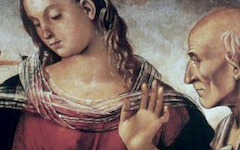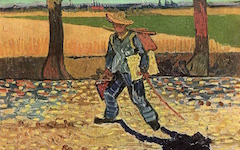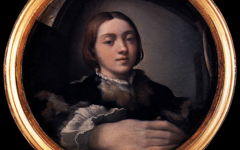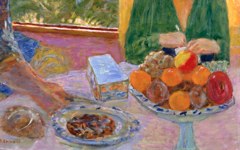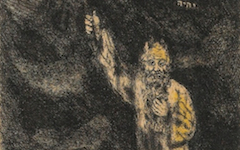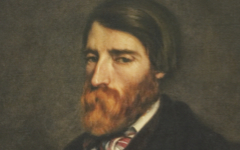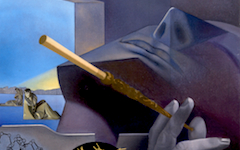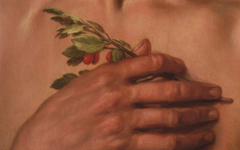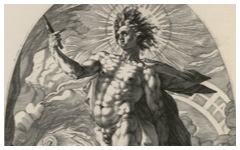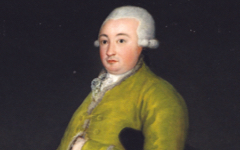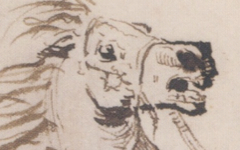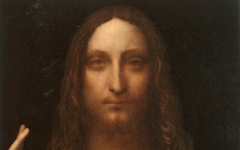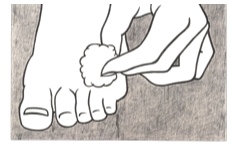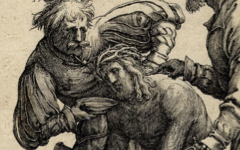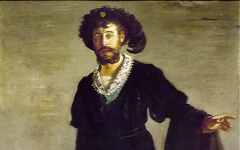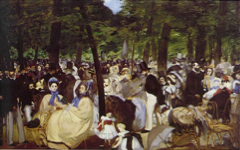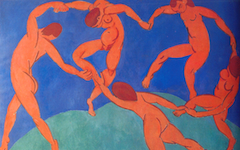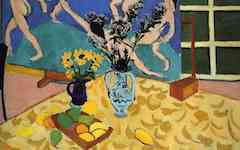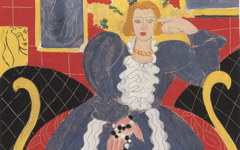Pointing and Touch
Of all the self-referential symbols an artist can use, the hand is paramount. It is often said that in the early Renaissance when artists were trying to gain recognition for themselves as intellectuals they played down the hand’s importance to their craft because it signalled manual labor. Paradoxically, though, the finger of God was also associated with creation, as in Michelangelo's Creation of Adam. An earlier, medieval illustration depicts the story of a miraculous image, worshipped in Gethsemane, of Mary and Christ impressed on stone and it shows God actually forming the sculpture with his own finger.{ref1} Both ideas persisted but once the artist's finger was recognized by contemporaries as the equal of poets, the hand became an even more potent symbol for the craft of painting while the eye or forehead continued to symbolize the art's conception or intellectual content. Today we even say as evidence of art’s authenticity: “it was done by his or her hand.”
Most Recent Articles
An excellent example of the invisible mirror in art
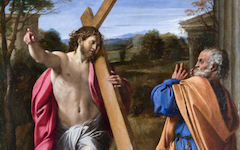
Carracci’s Christ appearing to St Peter on the Appian Way (1601-02)
All Articles (Alphabetical by Artist, then Title)
Find out how a giant Renaissance altarpiece is all about painting
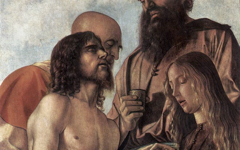
Bellini’s Pesaro Altarpiece (c. 1471/4)
Why would a great poet just depict fruit on a platter with no other content or meaning? The answer: they wouldn't.

Bonnard’s Fruit on a Red Tablecloth (c.1943)
How Bonnard turned his creative process into a scene in modern Paris
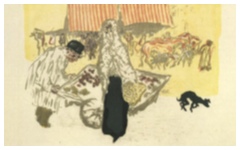
Bonnard’s The Pushcart (c.1897)
Pastoral genre scenes, although invented by Boucher, abide by art's traditions
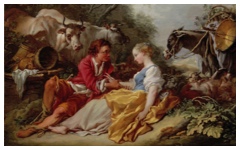
Boucher’s Pastoral landscape with a shepherd and shepherdess (c.1730)
Unless you knew that there might be a self-portrait in this Reclining Nude, you'd probably never see it.

Boucher’s Reclining Nude (1730’s)
An excellent example of the invisible mirror in art

Carracci’s Christ appearing to St Peter on the Appian Way (1601-02)
See how the inversion of the artist-model relationship helps express the androgyny of the artist's mind
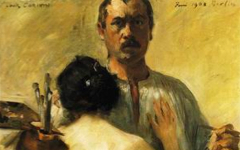
Corinth’s Self-Portrait with a Model (1903)
Find out how specialists have been on the right track too, even a contemporary.
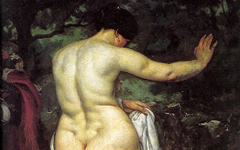
Courbet’s Corpulent Bathers: A Postscript
See how Durer shaped the Virgin and Child into the form of his own monogram
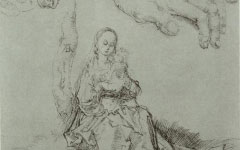
Dürer’s Virgin and Child (c.1491)
One of the easiest ways to find unseen features in paintings is to look for the artist's initials. Daumier included them more than most.
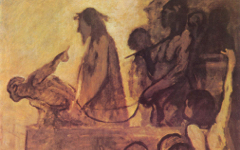
Daumier’s Ecce Homo (c.1849-52)
See how the meaning behind this image changes our entire understanding of Degas' oeuvre
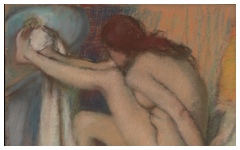
Degas’ Woman Drying Her Foot (1885-6)
Learn how to recognize the pointing pose of an artist and to confirm it through a play on words
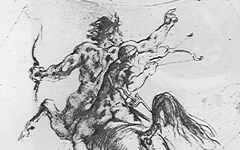
Delacroix’s Education of Achilles (c.1845)
Learn how an artist's sketches and unfinished drawings help explicate a painting
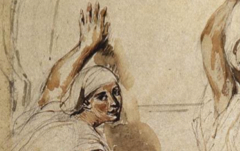
Delacroix’s Two Women at the Well (1832)
Find out how a little knowledge of studio life goes a long way
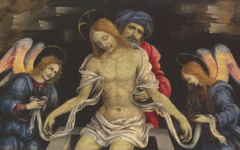
Filippino Lippi’s Dead Christ (c.1500) and the Artist’s Turban
Narrative paintings are meant to make sense. Take note of anything odd.
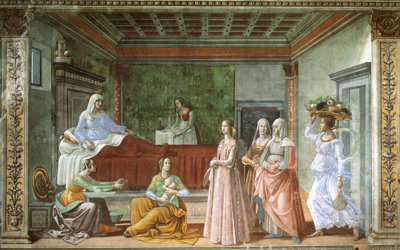
Ghirlandaio’s Birth of St John the Baptist (1486-90)
See how a classical legend becomes the perfect setting for an allegory on the artist's studio
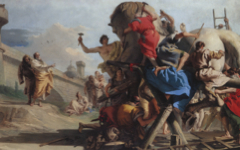
Giandomenico Tiepolo’s Building of the Trojan Horse (c.1773-4)
How tradition in art is more often based on forms than subject matter
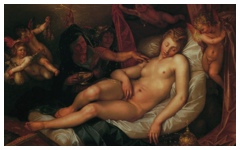
Goltzius’ Sleeping Danae… (1603)
Think about self-referential meaning and one scene can quickly turn into another
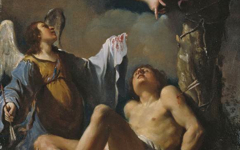
Guercino’s St. Sebastian Succoured by Two Angels (1617)
Find out how this portrait by Holbein represents the artist even if he had not also used face fusion

Holbein’s Jakob Meyer zum Hasen (1516)
Michael Lobel explains how several of Sloan's paintings of New York street scenes are really allegories on painting
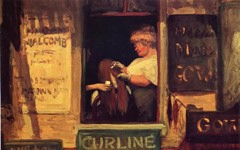
John Sloan’s Hairdresser’s Window (1907)
If a hand is missing, can it still represent the artist's craft?
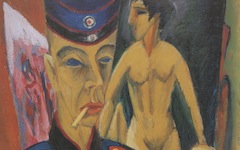
Kirchner’s Self-Portrait as Soldier (1915)
How Rivers invented (or perhaps just copied) another way an artist can symbolize the act of painting
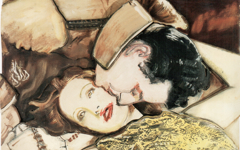
Larry Rivers’ A Vanished World: Gilbert and Garbo 1 (1994)
A 20th-century version of medieval angels playing stringed instruments. See how.

Lichtenstein’s Girl with an Accordion (1961)
Learn how "every painter paints" himself makes logical sense of even the most confused compositions

Lotto’s Virgin and Child with Saints Roch and Sebastian (c.1522)
There is more to the Tragic Actor than meets the eye. Find out what's there that others cannot see.
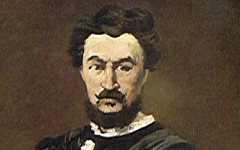
Manet’s Tragic Actor (1865-6) Part 2
How to recognize the Madonna and Child as a symbol of the artist
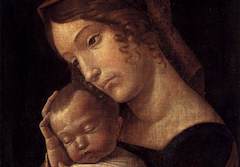
Mantegna’s Madonna with Sleeping Child (c.1465-70)
An early example of how art is a guide to what we now call "self-knowledge".
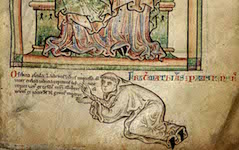
Matthew Paris’ Virgin and Child with Artist Kneeling (c.1250)
There is yet more meaning in the drawing as we see in Part 2 of this analysis
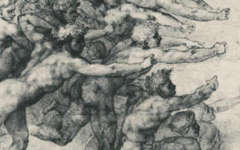
Michelangelo’s Archers Shooting at a Herm (c.1530) Part 2
Always look for what is odd. It's often there where you'll find a breakthrough in meaning
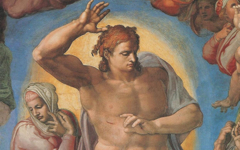
Michelangelo’s Christ in the Last Judgment (1534-41)
There's probably more unseen in Michelangelo's Sistine Chapel than has ever been known....
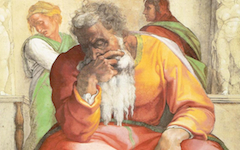
Michelangelo’s Sistine Ceiling: Jeremiah (c.1509-10)
See why Jonah is the most important figure in the chapel
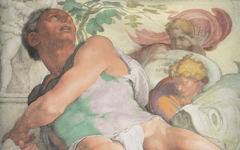
Michelangelo’s Sistine Ceiling: Jonah (1512)
© Simon Abrahams. Articles on this site are the copyright of Simon Abrahams. To use copyrighted material in print or other media for purposes beyond 'fair use', you must obtain permission from the copyright owner. Websites may link to this page without permission (please do) but may not reproduce the material on their own site without crediting Simon Abrahams and EPPH.
